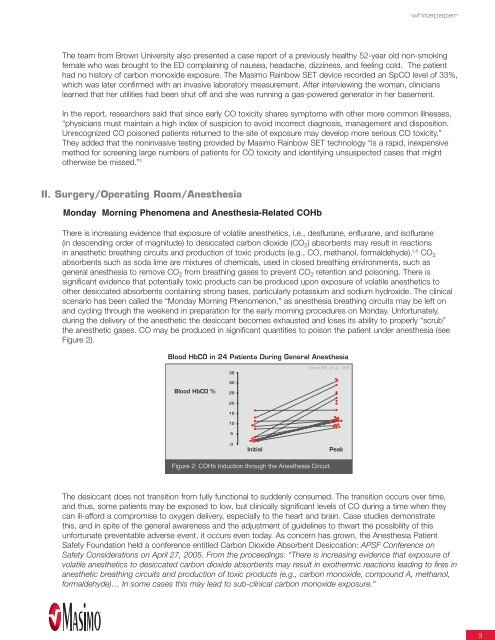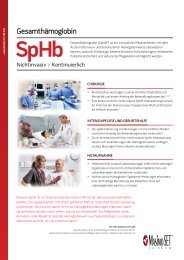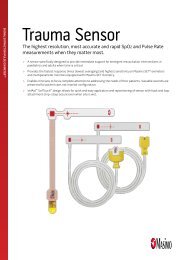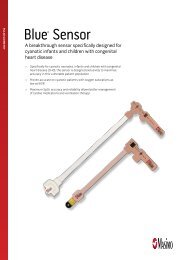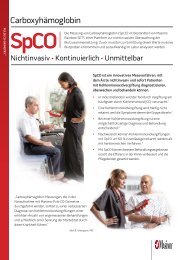Carboxyhemoglobin - Masimo
Carboxyhemoglobin - Masimo
Carboxyhemoglobin - Masimo
Create successful ePaper yourself
Turn your PDF publications into a flip-book with our unique Google optimized e-Paper software.
The team from Brown University also presented a case report of a previously healthy 52-year old non-smoking<br />
female who was brought to the ED complaining of nausea, headache, dizziness, and feeling cold. The patient<br />
had no history of carbon monoxide exposure. The <strong>Masimo</strong> Rainbow SET device recorded an SpCO level of 33%,<br />
which was later confirmed with an invasive laboratory measurement. After interviewing the woman, clinicians<br />
learned that her utilities had been shut off and she was running a gas-powered generator in her basement.<br />
In the report, researchers said that since early CO toxicity shares symptoms with other more common illnesses,<br />
“physicians must maintain a high index of suspicion to avoid incorrect diagnosis, management and disposition.<br />
Unrecognized CO poisoned patients returned to the site of exposure may develop more serious CO toxicity.”<br />
They added that the noninvasive testing provided by <strong>Masimo</strong> Rainbow SET technology “is a rapid, inexpensive<br />
method for screening large numbers of patients for CO toxicity and identifying unsuspected cases that might<br />
otherwise be missed.” 2<br />
II. Surgery/Operating Room/Anesthesia<br />
Monday Morning Phenomena and Anesthesia-Related COHb<br />
whitepaper<br />
There is increasing evidence that exposure of volatile anesthetics, i.e., desflurane, enflurane, and isoflurane<br />
(in descending order of magnitude) to desiccated carbon dioxide (CO 2) absorbents may result in reactions<br />
in anesthetic breathing circuits and production of toxic products (e.g., CO, methanol, formaldehyde). 3-6 CO 2<br />
absorbents such as soda lime are mixtures of chemicals, used in closed breathing environments, such as<br />
general anesthesia to remove CO 2 from breathing gases to prevent CO 2 retention and poisoning. There is<br />
significant evidence that potentially toxic products can be produced upon exposure of volatile anesthetics to<br />
other desiccated absorbents containing strong bases, particularly potassium and sodium hydroxide. The clinical<br />
scenario has been called the “Monday Morning Phenomenon,” as anesthesia breathing circuits may be left on<br />
and cycling through the weekend in preparation for the early morning procedures on Monday. Unfortunately,<br />
during the delivery of the anesthetic the desiccant becomes exhausted and loses its ability to properly “scrub”<br />
the anesthetic gases. CO may be produced in significant quantities to poison the patient under anesthesia (see<br />
Figure 2).<br />
The desiccant does not transition from fully functional to suddenly consumed. The transition occurs over time,<br />
and thus, some patients may be exposed to low, but clinically significant levels of CO during a time when they<br />
can ill-afford a compromise to oxygen delivery, especially to the heart and brain. Case studies demonstrate<br />
this, and in spite of the general awareness and the adjustment of guidelines to thwart the possibility of this<br />
unfortunate preventable adverse event, it occurs even today. As concern has grown, the Anesthesia Patient<br />
Safety Foundation held a conference entitled Carbon Dioxide Absorbent Desiccation: APSF Conference on<br />
Safety Considerations on April 27, 2005. From the proceedings: “There is increasing evidence that exposure of<br />
volatile anesthetics to desiccated carbon dioxide absorbents may result in exothermic reactions leading to fires in<br />
anesthetic breathing circuits and production of toxic products (e.g., carbon monoxide, compound A, methanol,<br />
formaldehyde)… In some cases this may lead to sub-clinical carbon monoxide exposure.”<br />
3


